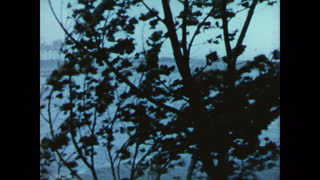Released in 1961, SECONDS FOR SURVIVAL was produced by AT&T / The Bell System and presented around the country by representatives of the phone company. The film tells how the North American Air Defense Command links NORAD, Sage, SAC, the DEW Line (Distant Early Warning), BMEWS, White Alice System, picket ships, Texas Towers blimps and air ships and air patrols into a single giant warning system to protect Americans from Soviet attack. The film begins with an overview of civilian communication issues — a woman calls the fire department to extinguish a fire at her house for instance — before moving on to a discussion about how communications will be employed in the event of a war with an unnamed adversary (clearly — the Soviet Union).
The film strongly reassures the viewer that technology can apparently provide peace of mind in the event of a disaster. Robust communications systems are being put in place, including buried phone lines and bypass systems that will preserve communications networks in the event of a disaster. The antiballistic missile Nike Zeus system is mentioned as a reliable ICBM interceptor.
The Distant Early Warning Line, also known as the DEW Line or Early Warning Line, was a system of radar stations in the far northern Arctic region of Canada, with additional stations along the North Coast and Aleutian Islands of Alaska, in addition to the Faroe Islands, Greenland, and Iceland. It was set up to detect incoming Soviet bombers during the Cold War, and provide early warning of any sea-and-land invasion.
The DEW Line was operational from 1957 to 1985 and it was the northernmost and most capable of three radar lines in Canada and Alaska; the joint Canadian-US Pinetree Line ran from Newfoundland to Vancouver Island, and the Mid-Canada Line ran somewhat north of this. Between 1988 and 1993, most stations were deactivated. Those that remained were upgraded as part of the new North Warning System.
The White Alice Communications System (WACS, “White Alice” colloq.) was a United States Air Force telecommunication network with 80 radio stations constructed in Alaska during the Cold War. It used tropospheric scatter for over-the-horizon links and microwave relay for shorter line-of-sight links. Sites were characterized by large parabolic, tropospheric scatter antennas as well as smaller microwave dishes for point to point links.
The system connected remote Air Force sites in Alaska, such as Aircraft Control and Warning (AC&W), Distant Early Warning Line (DEW Line) and Ballistic Missile Early Warning System (BMEWS), to command and control facilities and in some cases it was used for civilian phone calls. The system was advanced for its time, but became obsolete within 20 years following the advent of satellite communications.
We encourage viewers to add comments and, especially, to provide additional information about our videos by adding a comment! See something interesting? Tell people what it is and what they can see by writing something for example: “01:00:12:00 — President Roosevelt is seen meeting with Winston Churchill at the Quebec Conference.”
This film is part of the Periscope Film LLC archive, one of the largest historic military, transportation, and aviation stock footage collections in the USA. Entirely film backed, this material is available for licensing in 24p HD, 2k and 4k. For more information visit http://www.PeriscopeFilm.com


